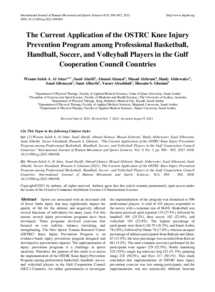Document
The current application of the OSTRC knee injury prevention program among professional basketball, handball, soccer, and volleyball players in the Gulf Cooperation Council countries.
Identifier
DOI: 10.13189/saj.2021.090508
Source
International Journal of Human Movement and Sports Sciences. v. 9, 5, p. 884-892
Contributors
Al-Arifi, Saud., Author
Al-Anazi, Ahmad., Author
Al-Zhrani, Msaad., Author
Al-Shewaier, Shady., Author
Al-Hosayni, Saad., Author
Al-Harbi, Sami., Author
Al-Raddadi, Yasser., Author
Ghulam, Hussain S., Author
Country
United States.
Publisher
Horizon Research Publishing.
Gregorian
2021-09-01
Language
English
Subject
English abstract
Sports are associated with an increased risk of lower limbs injury that may significantly impact the quality of life for the athletes and negatively affected several functions of individuals for many years. For this reason, several injury preventions programs have been developed. These programs involved exercises that focused on core stability, balance, stretching, and strengthening. The Oslo Sports Trauma Research Center (OSTRC) Knee Injury Prevention Program is an evidence-based injury prevention program designed and developed to prevent knee injuries. The implementation of injury prevention programs is a challenge in sports medicine. Therefore, the purpose of this study is to assess the implementation of the OSTRC Knee Injury Prevention Program among professional basketball, handball, soccer, and volleyball players in the Gulf Cooperation Council (GCC) Countries. An online questionnaire to investigate the implementation of the program was dismissed to 500 professional players. A total of 433 players responded to the survey with a response rate of 86.6%. Basketball was the most practiced sport reported 119 (27.5%), followed by handball 109 (25.2%), then soccer 102 (23.6%), and volleyball 103 (23.8%). The highest percentage of participants were from UAE 79 (18.2%), and Saudi Arabia 78 (18%), followed by Oman 76 (17.6%), whereas an equal percentage of athletes participated from Bahrain and Qatar; 67 (15.5%), the least percentage was recorded from Kuwait 66 (15.2%). The most common exercises performed by the participants were squat+ 229 (52.9%), Nordic hamstring 225 (52%), single-leg sideways hop 223 (51.5%), jumping lungs 218 (50.3%), and flyer 217 (50.1%). This study concluded that implementation of OSTRC knee injury prevention exercise was low among participants, and the implementation was not statistically different between different sports or GCC countries.
ISSN
2381-4381
Category
Journal articles

